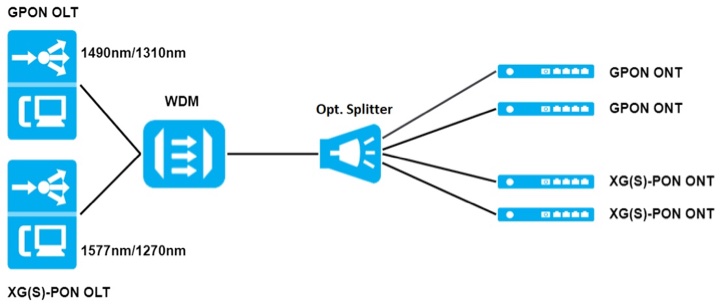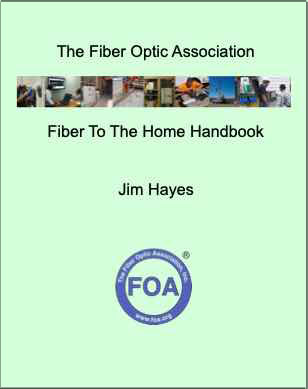FTTH
PON
Migration from GPON to XG(S)-PON
Vladimir Grozdanovic
Today, FTTx PONs are the most popular access networks. They have gained
great popularity in the last ten years due to the great demands of
subscribers for high data rates and the low cost of passive optical
networking equipment.
In general, PON networks offer a reliable, high-quality, and economical
solution. Comparing PON and access networks implemented with copper
cables (HFC, xDSL, etc.), there are a number of advantages. The most
important advantages are lower attenuation, high bandwidth, immunity to
interference, and low cost of passive optical equipment.
PON
The historical development of the ITU PON standard started with APON
(ATM-PON), after that BPON, then today's current standards GPON,
XG(S)-PON, and NG-PON2. The next generations of ITU PON standards are
50G-PON and 100G-PON. At the same time, the international organization
IEEE is developing its PON standards: EPON, 10G-EPON, 25G-EPON, etc.
The architecture of the PON system consists of three segments. The OLT
(Optical Line Terminal) is the main element of the system that enables
the connection of ONUs to MAN/WAN networks. The next segment is ODN
(Optical Distribution Network) - the fiber optic cable plnt. This is the
biggest and the most expensive element of this system. The task of the
ODN is to connect the ONUs (Optical Network Unit) to the OLT. The final
segment is ONU.
There are different FTTx PON scenarios: FTTC (w/DSL), FTTB, FTTH, and
FTTR. It depends on the ONU location. FTTH GPON is the most widespread
technology, however, due to the great demands of subscribers; today the
migration from GPON to XG(S)-PON FTTH is underway or nearing completion.
GPON enables a max 2.5Gbps/1.25 Gbps per PON port. These are enough data
rates for most residential users when used with a maximum spit of 32.
However, some services such as business applications and consumer online
gaming, AR/VR, telemedicine, 3D web scenes, holo chat applications, 4K
and 8K video, free viewpoint, etc. require higher data rates in both
directions. That is why the standards for migration from GPON to XGPON
or XGS-PON started.
XG(S)-PON enables higher data rates and lower latency compared to GPON.
Max data rates per PON port is 10/2.5 Gbps (XG-PON) or 10/10 Gbps
(XGS-PON). This standard is intended for all residential users and small
and medium enterprises. There are several different 10G PON
technologies (10G EPON, XG-PON, and XGS-PON), but telecommunications
operators generally use XGS-PON. A small of number telecommunications
operators introduced NG-PON2 or 25G-PON due to the demands of large
enterprises (large companies, factories, and 5G mobile operators). 100G
PONs are also in development.
Migration from GPON to XG(S)-PON
Telecommunications operators want an easy and safe migration to the new
PON standard. They want to save the most expensive part of the system -
the cable plant, ODN. GPON and XG(S)-PON use different wavelengths, which enables the coexistence of two PON standards in the same ODN. GPON uses 1490 nm for downstream and 1310 nm for upstream, and XG(S)-PON uses 1577 nm for downstream and 1270 nm for upstream.

Modern OLTs generally support GPON and XG(S)-PON boards. Because of
that, migration from GPON to XG(S)-PON can be realized using XG(S)-PON
service boards (hybrid solution) or combo/flex PON service boards.
Hybrid solution
A hybrid solution is a solution where GPON and XG(S)-PON service boards
are combined in the same OLT or in two or more independent OLTs. The
parallel operation of two PON standards in the same ODN is enabled by
using the WDM module (mux/demux). In this way, subscribers can use GPON
or XG(S)-PON.

This solution maintains the existing GPON boards, however, this solution
also introduces new component - WDM mux/demux. These WDM modules
require reorganization in headends (HE) or central offices (CO). In
addition, WDM modules increase IL (Insertion Loss) by about 1 to 1.5 dB.
Sometimes updating the OLT software or replacing the control boards is
required.
Combo or flex PON boards
The second and last solution is the solution with combo or flex PON
boards with both GPON and 10GPON on the board with one port. These boards are installed in the existing OLT. This means that
the existing GPON service boards are uninstalled. Combo or flex boards
have slots for SFP optical modules that combine GPON and XG(S)-PON, and
have built-in WDM mux/demux.

This solution does not introduce new elements and does not require
reorganization in HE or CO. Very rarely, updating the OLT software or
replacing the control boards is required. The main disadvantage of this
solution is the uninstallation of existing GPON boards.
Future development
The next steps are the mass introduction of 25G-PON, and the testing of
50G-PON. The main drivers of PON development are large enterprises,
factories, and 5G/6G mobile operators. Large telecommunications
operators in the USA and Europe use NG-PON2 and 25G-PON. The 50G-PON
standard is still in the testing phase. Commercial use of this PON
standard is still a distant future.
Vladimir Grozdanovic is a graduate electrical engineer for
telecommunications with more than 10 years of experience in access
networks (HFC and FTTH) in large cable operators in Serbia (SBB and
Jotel).
Technical
Information on FTTX From The FOA
Online Guide:
- FTTH
Introduction
- FTTH
Architectures,
- FTTH
in MDUs (Multiple Dwelling Units)
- FTTH
PON Standards, Specifications and Protocols
- FTTH
Design
- FTTH
Installation
- FTTH
Customer Premises Installation
FTTH
Network Testing
FTTH
Case Studies: Do-It-Yourself FTTH
FTTH
Project Management
Migration from GPON to XG(S)-PON
Migration from CATV HFC To PON
- The
Fiber Optic Association Fiber To The Home Handbook:
For Planners, Managers, Designers, Installers And
Operators Of FTTH - Fiber To The Home - Networks

The
Fiber Optic Association Fiber To The Home
Handbook Available
in paperback or as an eBook on the Amazon
Kindle Available
direct from Amazon.com,
local booksellers and other distributors.
- Training
& Certification
Fiber
U Online FTTx Self Study Program (free)
- FOA
Certification Overview
FOA
FTTx Certification Requirements
FOA-Approved
Training Programs
Table of Contents: The
FOA Reference Guide To Fiber Optics
|
